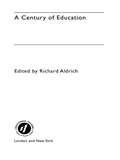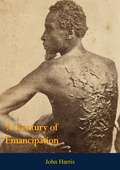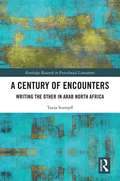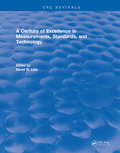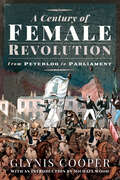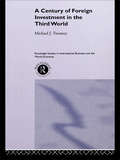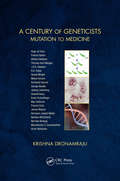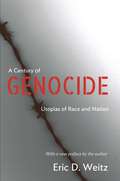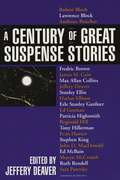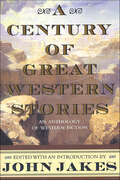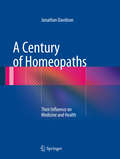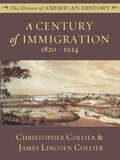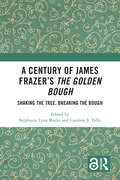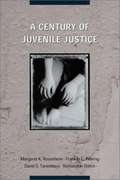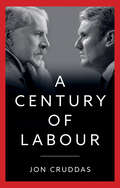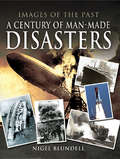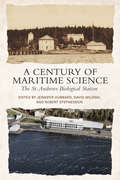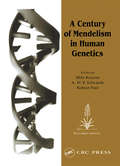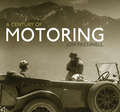- Table View
- List View
A Century of Education (Education K-12 Ser. #14)
by Richard AldrichEducation is a country's biggest business and the most important shared experience of those who live in it. A Century of Education provides an accessible, authoritative and fascinating overview of the role and nature of education in the twentieth century. Eminent historian of education, Professor Richard Aldrich has assembled a team of contributors, all noted experts in their respective fields, to review the successes and failures of education in the last century and to look forward to the next. A succinct overview of twentieth century social, economic, political and intellectual developments in the first chapter is followed by chapters on ten key topics. Each chapter has four sections: a review of the educational situation in 2000; a similar assessment in 1900; changes and continuities throughout the century; and a conclusion reviewing the lessons for today and tomorrow. This is a work of information, interpretation and reference, which demonstrates the strengths and weaknesses of education during the twentieth century and identifies educational priorities for the twenty first. For anyone interested in what has become the most important Issue of our time, this unique book is set to become a classic text.
A Century of Emancipation
by John HarrisA Century of Emancipation, written by the English anti-slavery campaigner John Harris and first published in 1933, represents an invaluable compendium for the student of slavery and its allied forms of contract labor and forced labor, both in their historical setting and in their contemporary aspects. In this book, the author is concerned with all kind of slavery, including that of East Indians and Mongolians in the West Indies, of Kanakas in Polynesia, and of the motley crowd along the Putumayo River in South America.This book is not merely an attempt to portray suffering, it is also an attempt to give a brief account of the systems under which these things have been done, and still more an effort to recount the light and shade of the great struggles carried on by a mere handful of earnest souls beginning with Clarkson, Wilberforce, Buxton, Pitt, Sturge, Macaulay, Lushington. Grey, Livingstone, then on to Vandervelde, Dilke, Fox Bourne, Morel, Hodgkin and others.The book shows how those who have struggled and are still struggling with these sordid but powerful forces have never numbered more than a few hundreds. Whilst it may be true that those few hundreds have been men and women of wisdom and influence, yet it is even more true that they have been men and women possessed of souls burning with a spiritual passion for freedom and justice—that was and is their chief source of strength.
A Century of Encounters: Writing the Other in Arab North Africa (Routledge Research in Postcolonial Literatures)
by Tanja StampflA Century of Encounters analyzes Arab, American, and European literary depictions of self and other as they interact with each other in Arab North Africa throughout the twentieth century and introduces the trope of the encounter as a lens through which to read contemporary world literature comparatively. A focus on the transnational encounter allows for the in-depth study of constructions of gender, race, and national identities both for the self and the other in order to answer the seemingly simple questions: What makes up different encounters in the twentieth century, and how can we facilitate a productive and positive encounter between these groups? This book illustrates connections between literary texts that have hitherto been overlooked and establishes an intertextual genealogy of transcultural encounters throughout the twentieth century that coalesce around the themes of desire, family, and travel. In its literary analysis, A Century of Encounters aims to facilitate a better understanding of other cultures in general and contribute to constructive cross-cultural interactions between the United States, Europe, and Arab North Africa in particular.
A Century of Excellence in Measurements, Standards, and Technology
by David R. LideEstablished by Congress in 1901, the National Bureau of Standards (NBS), now the National Institute of Standards and Technology (NIST), has a long and distinguished history as the custodian and disseminator of the United States' standards of physical measurement. Having reached its centennial anniversary, the NBS/NIST reflects on and celebrates its first century with this book describing some of its seminal contributions to science and technology. Within these pages are 102 vignettes that describe some of the Institute's classic publications. Each vignette relates the context in which the publication appeared, its impact on science, technology, and the general public, and brief details about the lives and work of the authors.The groundbreaking works depicted include:A breakthrough paper on laser-cooling of atoms below the Doppler limit, which led to the award of the 1997 Nobel Prize for Physics to William D. PhillipsThe official report on the development of the radio proximity fuse, one of the most important new weapons of World War IIThe 1932 paper reporting the discovery of deuterium in experiments that led to Harold Urey's1934 Nobel Prize for ChemistryA review of the development of the SEAC, the first digital computer to employ stored programs and the first to process images in digital formThe first paper demonstrating that parity is not conserved in nuclear physics, a result that shattered a fundamental concept of theoretical physics and led to a Nobel Prize for T. D. Lee and C. Y. Yang "Observation of Bose-Einstein Condensation in a Dilute Atomic Vapor," a 1995 paper that has already opened vast new areas of research A landmark contribution to the field of protein crystallography by Wlodawer and coworkers on the use of joint x-ray and neutron diffraction to determine the structure of proteins
A Century of Female Revolution: From Peterloo to Parliament
by Glynis CooperThis dramatic social history follows the struggle for women’s rights in England from the Industrial Revolution to the Suffragist victory after WWI.The 100 years from 1819-1919 saw remarkable change for women in England. From the early nineteenth century, when women were not even considered ‘persons' under the law, they achieved full legal rights and status. The doors of education and employment were thrown open to them, and by 1919, they won universal suffrage.As workers organized in the North-West to demand better conditions in the textile industries, women formed their own groups to support the cause—and fight for their own rights. Blowback came in August of 1819, in the form of the Peterloo Massacre.The brutality of that day brought attention to the women’s cause and encouraged them to continue the fight. Women became involved in reform groups, Chartism, trade unions, politics, education, career opportunities and the right to vote. Though they faced hostility from both men and women, their perseverance paid off for generations of women to come.
A Century of Fiction in The New Yorker: 1925-2025
by New Yorker Magazine IncEdited by The New Yorker's fiction editor, Deborah Treisman, a celebratory selection from one hundred years of short stories in the magazine which has been the most influential and important showcase for the form and has launched dozens of stellar careers in fictionThere is simply no A–Z like the alphabet of fiction writers who have appeared in the pages of The New Yorker in the last hundred years. The book boasts inarguable classics like Salinger&’s &“A Perfect Day for Bananafish,&” Annie Proulx&’s &“Brokeback Mountain,&” and Shirley Jackson&’s &“The Lottery&” alongside stunners to be rediscovered. Some stories defined a moment or a now-lost world (Isaac Bashevis Singer&’s &“The Cafeteria&”); others showed us a whole new way fiction could sound and feel (&“The Red Girl,&” by Jamaica Kincaid). With this vivid selection, Treisman showcases how our fiction has changed over time, and reminds us that past literary fashions continue to ripple outward in the fiction we love today. What does a Donald Barthelme mean to the craft of short fiction now? What will a Yiyun Li mean to the next generation of readers and writers? This exquisite tour of the form as practiced at its highest level will leap directly into the hearts of readers of all ages, all stripes, and is a beautiful tribute to the magazine's influence on our literary culture over the last century.
A Century of Foreign Investment in the Third World (Routledge Studies in International Business and the World Economy)
by Michael TwomeyThe late twentieth century has witnessed a dramatic upsurge in foreign direct investment in the Third World. Based upon thorough statistical analysis, the book presents exhaustive case-studies of foreign investment policy in 'metropolitan' countries and of the experiences of 'host' countries throughout Africa, Asia and Latin America. With a wide geographical and historical focus, it also makes an important contribution to current debates on dependency theory.
A Century of Geneticists: Mutation to Medicine
by Krishna DronamrajuGenetics, like all scientific disciplines, is a human endeavor. Thus, the lives of geneticists - their friendships, colleagues and associations - play an important role in the historical development of the science. This book summarizes the history of genetics by reviewing the lives of the prominent and influential researchers beginning with the earliest and simplest branches of genetics (studies of inheritance and mutation) and ending with the human genome project - the pinnacle of genetics research of the 20th century. Key selling features: Summarizes the lives of important genetics researchers Reviews the development of important foundational concepts Highlights the way new technologies and methods have advanced the study of genetics Explores the influence of genetics in other biomedical fields Avoids simplistic chronological summary of genetics
A Century of Genocide: Utopias of Race and Nation - Updated Edition
by Eric D. WeitzWhy did the twentieth century witness unprecedented organized genocide? Can we learn why genocide is perpetrated by comparing different cases of genocide? Is the Holocaust unique, or does it share causes and features with other cases of state-sponsored mass murder? Can genocide be prevented?Blending gripping narrative with trenchant analysis, Eric Weitz investigates four of the twentieth century's major eruptions of genocide: the Soviet Union under Stalin, Nazi Germany, Cambodia under the Khmer Rouge, and the former Yugoslavia. Drawing on historical sources as well as trial records, memoirs, novels, and poems, Weitz explains the prevalence of genocide in the twentieth century--and shows how and why it became so systematic and deadly.Weitz depicts the searing brutality of each genocide and traces its origins back to those most powerful categories of the modern world: race and nation. He demonstrates how, in each of the cases, a strong state pursuing utopia promoted a particular mix of extreme national and racial ideologies. In moments of intense crisis, these states targeted certain national and racial groups, believing that only the annihilation of these "enemies" would enable the dominant group to flourish. And in each instance, large segments of the population were enticed to join in the often ritualistic actions that destroyed their neighbors.This book offers some of the most absorbing accounts ever written of the population purges forever associated with the names Stalin, Hitler, Pol Pot, and Milosevic. A controversial and richly textured comparison of these four modern cases, it identifies the social and political forces that produce genocide.
A Century of Global Economic Crises: Monetary Policy in Search of An Anchor
by Lúcio Vinhas de SouzaThis book explores the end of the era of low inflation and stable price increases, known as “The Great Moderation”, and the impact this will have on monetary policy. The macroeconomic trends and economic policy issues observed within developed countries over the last 70 years are linked with the economic theory debates of the time to highlight how the current economic challenges came about. The limitations of past economic policies are highlighted to help create a new policy framework for an era defined by high inflation, low economic growth, large budget deficits, and increased private sector debt.This book presents a new understanding of monetary policy that engages with the changing behaviour of economic agents. It will be relevant to researchers and policymakers interested in monetary policy and the political economy.
A Century of Great Suspense Stories
by Various Jeffery DeaverNew York Times bestselling author Jeffery Deaver's enviable task? Choose the best mystery/horror detective stories from a century of work by the world's most celebrated writers. The result is a triumph, featuring masterpieces of suspense by:<P> Robert Bernard * Robert Bloch * Lawrence Block * Anthony Boucher * Frederic Brown * James M. Cain * Max Allan Collins * Jeffery Deaver * Stanley Ellin * Harlan Ellison * Erle Stanley Gardner * Ed Gorman * Anna Katharine Green * Jeremiah Healy * Patricia Highsmith * Reginald Hill * Tony Hillerman * Evan Hunter * Stephen King * John Lutz * John D. MacDonald * Ross MacDonald * Michael Malone * Steve Martini * Sharyn McCrumb * Margaret Millar * Marcia Muller * Sara Paretsky * Bill Pronzini * Ellery Queen * Ruth Rendell * Lisa Scottoline * Georges Simenon * Mickey Spillane * Rex Stout * Janwillem van de Wetering * Donald E. Westlake
A Century of Great Western Stories: An Anthology of Western Fiction
by John JakesJohn Jakes, #1 New York Times bestselling author of such acclaimed historical novels as North and South and The Kent Family Chronicles compiled in one volume a century's worth of his favorite American Western fiction. To illustrate the evolution of the genre, Jakes has included such legendary authors as Owen Wister, Louis L'Amour, and Zane Grey along side their more contemporary peers such as Loren Estleman and Elmer Kelton. While the stories have changed over the years, certain timeless themes of Western fiction remain constant. At the heart of the stories are ideas that have become synonymous with the American dream--the frontier spirit, individual freedoms, and man's relationship with the land. A Century of Great Western Stories is essentially a retrospective of western writing over the past century, but Jakes also sets out to give readers a glimpse of what the future might hold for western fiction. While trends in publishing might not always be promising, the current crop of contemporary Western authors show that the old west will always have a place in the world of fiction. Like the American dream which it celebrates, Western fiction will persevere.At the Publisher's request, this title is being sold without Digital Rights Management Software (DRM) applied.
A Century of Hairstyles
by Pamela GibsonNothing defines a person like their hairstyle - and what a century it has been for hair! Bangs, bobs, buns, beehives and bouffants have vied with pixie cuts, pin curls, perms and pageboys for ascendancy in an ever-changing parade of ladies' looks and trends, and among the men we've seen Caesers, comb overs, ducktails, faux hawks, flattops, quiffs and slick backs. From the Edwardian era through the seismic changes of the '20s and '60s, and including every quirky twist hair history took on its way to the turn of the millennium, this book is a lush visual survey of a hundred years of hair styles and the great stylists of the century including Jackie Kennedy's stylist Mr. Kenneth and innovators like Vidal Sassoon.
A Century of Homeopaths: Their Influence on Medicine and Health
by Jonathan DavidsonAs the values of integrative medicine continues to grow, alternative points of view and treatments are increasing in acceptance and prevalence. Homeopathic medicine is considered an important root to this approach. However, contributions of homeopathically qualified doctors have long been overlooked. A Century of Homeopaths is a detailed account of the many homeopaths who have contributed to medical progress since 1840. The accomplishments of over 100 homeopaths form the organizing structure of the book - many of whom have been lost to history. The text describes the ways in which homeopaths have influenced medical practice, research and public health, as well as the seminal effect of homeopaths in the emergence of today's medical specialties and in social reform, thus providing insights to healthcare professionals, researchers, students and medical historians.
A Century of Immigration: 1820 - 1924
by James Lincoln Collier Christopher CollierHistory is dramatic -- and the renowned, award-winning authors Christopher Collier and James Lincoln Collier demonstrate this in a compelling series aimed at young readers. Covering American history from the founding of Jamestown through present day, these volumes explore far beyond the dates and events of a historical chronicle to present a moving illumination of the ideas, opinions, attitudes and tribulations that led to the birth of this great nation. A Century of Immigration reviews the century of 1820 through 1920, in which there were two waves of immigration to the United States. This book discusses the varied motivations and nationalities of these new Americans, as well as the effects of mass immigration on the country as a whole, and the rise of antiforeign sentiments among more recent immigrants. The text is enhanced with photographs, and images of historic art & artifacts.
A Century of Interspecific Hybridization and Introgression in Tobacco
by Apoloniusz BerbećThis is the first comprehensive monograph dedicated to using Nicotiana species for tobacco genetic improvement. Unlike typical chapters constrained by size and scope, this book offers a detailed species-by-species analysis, with 27 tables providing relevant information. It marks a shift from focusing on specific topics to giving due attention to individual species. The review reflects on a century of exploiting Nicotiana species for usable germplasm and serves as an exhaustive guide to global literature on the subject, citing nearly 1000 literature items.The review delves into the involvement of Nicotiana species in interspecific hybrids with cultivated tobacco, covering sexual and asexual methods, including grafting. It addresses challenges in hybridization, such as cross incompatibility, maternal phenotypes, interspecific incongruity, lethality, and sterility, providing methods to overcome these barriers. Records on disease resistance for each Nicotianae species are compiled, and mechanisms of introgression, barriers, and limitations are discussed. The book lists Nicotiana species as successful donors of cytoplasmic genetic factors leading to cytoplasmic male sterility (CMS) and discusses negative effects of alien cytoplasm, providing a list of agronomically acceptable CMS sources. Controversial issues, including the identity of genetic accessions, are explored. The book concludes with an updated list of all reported interspecific combinations for Nicotiana.Primarily aimed at scholars and students interested in the genus for genetic diversity, this book serves as a historical reference guide to the realized and potential uses of Nicotiana species in tobacco improvement.
A Century of James Frazer’s The Golden Bough: Shaking the Tree, Breaking the Bough
by Stephanie Lynn Budin and Caroline J. TullyThis multidisciplinary volume examines the ongoing effects of James G. Frazer’s The Golden Bough in modern Humanities and its wide-ranging influence across studies of ancient religions, literature, historiography, and reception studies.The book begins by exploring the life and times of Frazer himself and the writing of The Golden Bough in its cultural milieu. It then goes on to cover a wide range of topics, including: ancient Near Eastern religion and culture; Minoan religion and in particular the origins of notions of Minoan matriarchy; Frazer’s influence on the study of Graeco-Roman religion and magic; Frazer’s influence on modern Pagan religions; and the effects of Frazer’s works in modern culture and scholarship generally. Chapters examine how modern academia and beyond continues to be influenced by the otherwise discredited theories in The Golden Bough, ideas such as Sacred Marriage and the incessant Fertility of Everything. The book demonstrates how scholarship within the Humanities as well as practitioners of alternative religions and the common public remain under the thrall of Frazer over one hundred years since the publication of the abridged edition of The Golden Bough, and what we must do to shake off that influence. A Century of James Frazer’s The Golden Bough is of interest to scholars and students from a wide range of disciplines, including Ancient History, History of Religion, Comparative Religion, Classical Studies, Archaeology, Historiography, Anthropology, Folklore, and Reception Studies.Chapter 18 of this book is freely available as a downloadable Open Access PDF at http://www.taylorfrancis.com under a Creative Commons Attribution (CC-BY) 4.0 license.
A Century of Juvenile Justice
by Margaret K. Rosenheim Bernardine Dohrn David S. Tanenhaus Franklin E. ZimringSince its inception in Illinois in 1899, the juvenile court has become a remarkable legal and social institution all over the developed world, one that plays a singular role in modern government. At its founding, the juvenile court was intended to reverse longstanding legal traditions, and place the child's interests first in areas of law ranging from dependency to delinquency. Yet in recent years legal responses to youths' offenses have undergone striking changes, as more juveniles are being transferred to adult courts and serving adult sentences. A Century of Juvenile Justice is the first standard, comprehensive and comparative reference work to span the history and current state of juvenile justice. An extraordinary assemblage of leading authorities have produced a accessible, illustrated document, designed as a reference for everyone from probation personnel and police to students, educators, lawyers, and social workers. Editors' introductions place into context each of the book's five sections, which consider the history of the ideas around which the system was organized and the institutions and practices that resulted; the ways in which this set of institutions and practices interacts with other aspects of government policy toward children in the U.S. and in other nations; and also the ways in which changing social and legal meanings of childhood and youth have continued to influence juvenile justice. The doctrine and institutions of juvenile justice in Europe, Japan, England, and Scotland are profiled in depth to show the range of modern responses to youth crime and child endangerment. This comparative material provides a fresh basis for judging the direction of policy in the U.S.
A Century of Labour
by Jon CruddasBritain’s first Labour government took office on 22 January 1924. Its centenary provides an opportunity to reassess the party's performance over the last 100 years, and with an election pending, the character and purpose of the modern party. Labour defined the dominant political settlement of much of the Twentieth Century: the welfare state. It has achieved much in pursuit of material change, social reform and equality. It has challenged patriarchy, racism and the legacy of imperialism, promoted human rights and delivered democratic and constitutional renewal. Yet any honest assessment must acknowledge a century littered with failures and missed opportunities. In this compelling book, Jon Cruddas, one of the country's foremost experts on Labour politics, details the vivid personalities and epic factional battles, the immense achievements and profound disappointments that define a century of Labour. Uniquely framed around competing visions of socialist justice within the Party, he provides a way to rethink Labour history, the divisions and factions on the left and to reassess key figures at the helm of the movement from Keir Hardie through to Keir Starmer.
A Century of Man-Made Disasters: A Century Of Man-made Disasters (Images of the Past)
by Nigel BlundellA pictorial history of the major man-made calamities that shocked the world throughout the twentieth century. It was a period during which the power and scale of industrialization changed the planet—an unforeseen consequence being the creation of more human-created catastrophes than ever before experienced. The events recorded here include the needless carnage of history&’s worst air disaster when two jumbo jets collided on the island of Tenerife. We recall the horrors of Aberfan, the Welsh village in which schoolchildren were buried alive. The story of the explosion aboard the Challenger space shuttle reveals how warnings that were ignored led to the deaths of seven astronauts. And we report on the failings that caused the nuclear nightmare at Chernobyl, a poisonous blot on the face of the globe. These and the other tragedies in this book were all man-made and, it seems, just waiting to happen. A further link between these horrific events is that they were all caused by either folly or greed—or both. But despite the tales of monstrous misfortune, many also produced heart-lifting stories of heroism, selflessness, sacrifice, and human resilience.
A Century of Man-Made Disasters: A Century Of Man-made Disasters (Images of the Past)
by Nigel BlundellA pictorial history of the major man-made calamities that shocked the world throughout the twentieth century. It was a period during which the power and scale of industrialization changed the planet—an unforeseen consequence being the creation of more human-created catastrophes than ever before experienced. The events recorded here include the needless carnage of history&’s worst air disaster when two jumbo jets collided on the island of Tenerife. We recall the horrors of Aberfan, the Welsh village in which schoolchildren were buried alive. The story of the explosion aboard the Challenger space shuttle reveals how warnings that were ignored led to the deaths of seven astronauts. And we report on the failings that caused the nuclear nightmare at Chernobyl, a poisonous blot on the face of the globe. These and the other tragedies in this book were all man-made and, it seems, just waiting to happen. A further link between these horrific events is that they were all caused by either folly or greed—or both. But despite the tales of monstrous misfortune, many also produced heart-lifting stories of heroism, selflessness, sacrifice, and human resilience.
A Century of Maritime Science: The St Andrews Biological Station
by Edited by Jennifer Hubbard David Wildish Rob StephensonLocated on the Bay of Fundy, the St. Andrews Biological Station is Canada's oldest permanent marine research institution. A Century of Maritime Science reviews the fisheries, environmental, oceanographic, and aquaculture research conducted over the last hundred years at St. Andrews from the perspective of the participating scientists. Introductory essays by two leading historians of science situate the work at St. Andrews within their historical context. With topics including the contributions of women to the early study of marine biology in Canada; the study of scallops, Atlantic salmon, and paralytic shellfish poisoning; and the development of underwater camera technology, A Century of Maritime Science offers a captivating mixture of first-hand reminiscences, scientific expertise, and historical analysis.
A Century of Mendelism in Human Genetics
by Milo Keynes A.W.F. Edwards Robert PeelIn 1901 William Bateson, Professor of Biology at Cambridge, published a renewed version of a lecture which he had delivered the year before to the Royal Horticultural Society in London (reprinted in the book as an appendix). In this lecture he recognized the importance of the work completed by Gregor Mendel in 1865, and brought it to the notice of
A Century of Motoring
by Jon PressnellBy 1914 the motor car had taken its definitive form. Tiller steering had at last disappeareed (in 1911 when Lanchester abandoned it); the front engined rear-wheel drive stystem Panhard was almost universal, unit construction was being essayed (the Lagonda 11.9hp); coachwork was moving away decisively from its horse-carriage roots. A new industry was forming, with mass-production by Ford and Morris poised to drive car-ownership upwards. The First World War, precipitated by the assassination of a car-borne royal, was to be the first motorized conflict, and one that would see a generation of soldiers gaining experience of the automobile.A Century of Motoring charts the progress of motoring from this nodal point to where we are today --more mobile than ever, but with environmental concerns shaping the way cars are made, use, and ultimately discarded. Through 50 carefully-chosen photographs it examines the steady democratization of motoring, the development of the British motor industry, and the place of the car in British life. Along the way it depicts the landmark models that are part of this rich history --the Model T Ford, the Austin Seven, the Jaguar E-type, the Mini --but doesn't forget the oddballs that have added so much color to the motoring scene, specials, and the bubble cars of the Suez era.
A Century of Naval Aviation, 1909–2009: The Evolution of Ships and Shipborne Aircraft
by David WraggAbove the Waves is the history of the first century of British Naval aviation, with personal accounts adding color to the achievements both in technology, such as angled flight decks, mirror deck landing systems, helicopter assault and vertical take-off, and in operations, including the sinking of the Konigsberg and the daring attack on the Italian fleet at Taranto, convoy protection, operations with the United States Navy in the Pacific, then, post-war, Suez, and later the recovery of the Falklands from Argentine invasion.The Royal Navy was in the forefront of aviation from a very early stage. As the author reveals Officers such as the legendary Admiral of the Fleet Lord Fisher quickly recognized the strategic and tactical importance of air power. Winston Churchill, as First Lord of the Admiralty, volunteered the Navy for the air defense of the UK in WW1 but with the formation of the RAF in 1918 the Navy had a fierce fight to retain its own air arms and this is a struggle that has continued up to the present day.Not only are there many thrilling accounts of operations but this fascinating book also includes a chronology of major events. Above the Waves will appeal to those who have served, those who serve today and those who intend to serve in the future, and for their relatives and the many enthusiasts who sense the particular excitement of air operations at sea.
